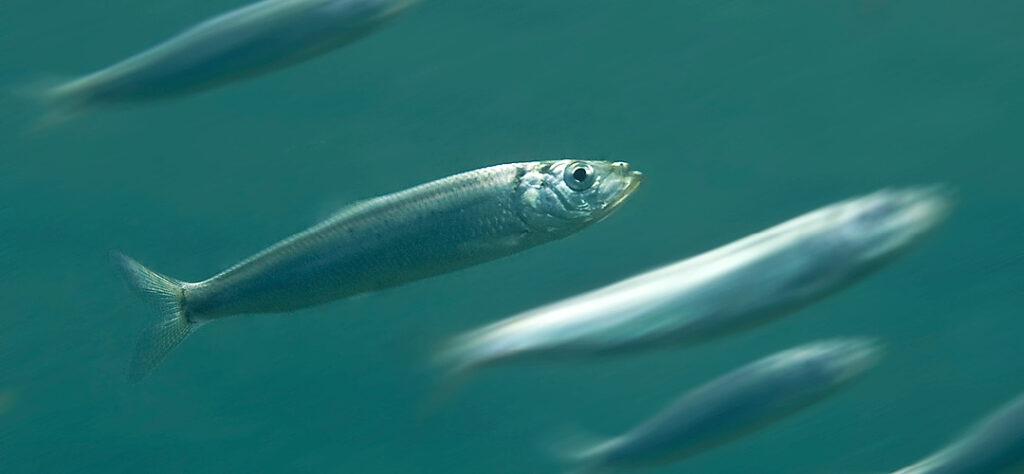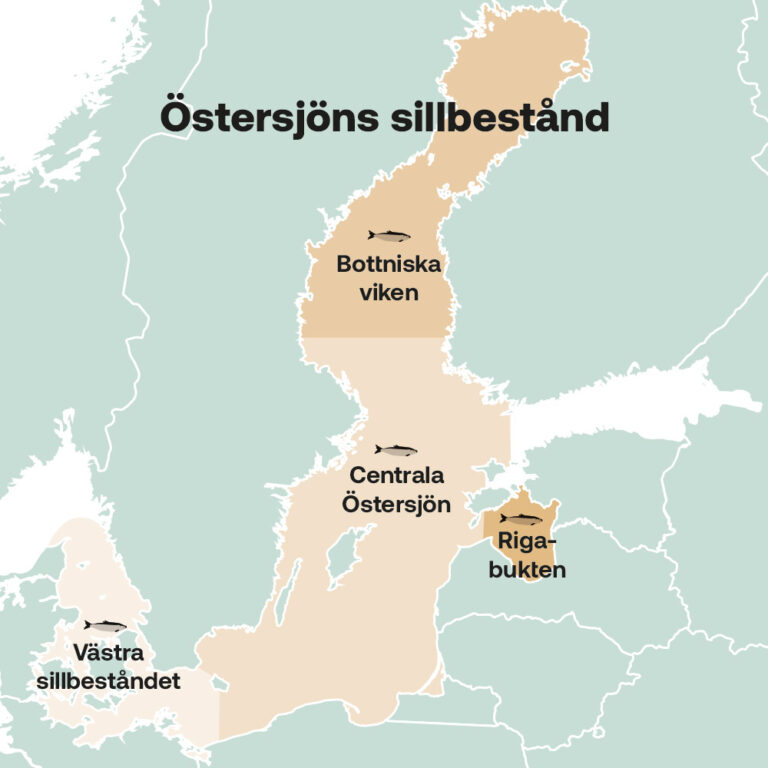Baltic herring
Herring is one of the most common fish in the world. It is a marine fish species that has adapted to the brackish waters of the Baltic Sea. Herring spawns all the way up in the Gulf of Bothnia, where the salinity is as low as 2–3 per mille, compared to 35 per mille in the Atlantic. But salinity is far from the only thing that is different in the Baltic Sea compared to the Atlantic. There are also major differences in how much the temperature varies during the year, light conditions in the water, plankton production, and which predators hunt the fish.

Shoal of herring. Photo: Tobias Dahlin
The role of herring in the ecosystem
Herring is often referred to as the engine of the Baltic Sea ecosystem because it is food for several different species, including cod, salmon, pike, birds, and seals. Herring itself mainly eats zooplankton, but until recently, researchers have found herring that eat fish. The discovery is not entirely new; the so-called piscivorous herring—a large herring—has been described in history books, but it was only recently that researchers were able to determine that it is a genetically unique group. The large herring eats sticklebacks in the coastal zone, among other things, and therefore can play a role in keeping stickleback populations down.
If the herring were to disappear, it would have major consequences for the ecosystem, from plankton all the way up the food chain to large predatory fish and marine mammals.
Herring fishing in the Baltic Sea
In the Baltic Sea, herring is managed in four different stocks – the herring stock in the Gulf of Bothnia, the central Baltic Sea, the Gulf of Riga, and the western Baltic Sea. However, research shows that there may be as many as 10–15 different herring populations in the Baltic Sea – groups of individuals of the same species that may differ in genetics, appearance, and behavior. By not taking different populations into account in management, there is a risk that entire herring populations will be depleted.

There are four different herring stocks in the Baltic Sea.
Herring has been an important part of our diet for centuries, but that is no longer the case. Herring stocks in the central Baltic Sea have declined by over 70 percent between 1966 and 2024. In 2024, industrial fishing accounted for just over 90 percent of the Swedish catch of herring and sprat—catches that are turned into fishmeal and oil and used as animal feed in salmon farms and chicken farms. At the same time, researchers and coastal fishermen report that herring have become smaller—it is increasingly difficult to catch large herring for human consumption. A four-year-old herring weighed an average of 33 grams in 2023, which is barely half of what it weighed in 1980. At the same time, herring are reaching sexual maturity at an earlier age.

Catches of herring in the central Baltic Sea. Catches in thousand tonnes is expressed on y-axis, year is shown on the x-axis.
Herring spawning
In the Baltic Sea, there are herring populations that spawn in both spring and autumn. The female lays eggs at a depth of about 0-10 meters, which sink to the bottom and stick to plants and rocks. The water temperature affects how long it takes for the small yolk sac larva to hatch. Once the nutrients in the yolk sac are used up, the larva begins to hunt zooplankton and later also eats smaller bottom-dwelling animals. Herring spend their early life along the coast and then swim out to sea to live in shoals, but they often return to the same place where they hatched to spawn. This is called homing behaviour.
How does the Baltic Sea environment affect herring?
Eutrophication
Nutrients are essential for life in the Baltic Sea. Phytoplankton need nutrients (phosphorus and nitrogen) to grow and, in the next stage, they are an important food source for other organisms such as zooplankton. However, too many nutrients can lead to eutrophication. In an eutrophic sea, certain algae can grow unchecked. Herring, which lay their eggs on hard bottoms where they stick to sand or stone, are disadvantaged when these environments become overgrown with fine-threaded algae or covered with organic material. Eutrophication affects many aspects of life in the Baltic Sea, from light conditions and oxygen conditions to the food web as a whole, which can have consequences for the herring’s food supply, among other things.
Salinity
Like many other species in the Baltic Sea, herring live at the limits of their range. Herring, a marine fish species, have adapted to the unique environment and low salinity of the Baltic Sea. Baltic herring are smaller in size than herring on the west coast, and herring in the Bothnian Sea are even smaller than herring in the southern Baltic Sea. One contributing factor is believed to be the salinity. The Baltic Sea has varying salinity, with the highest salinity in the southern Baltic Sea, becoming increasingly fresher further north.
